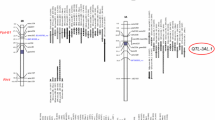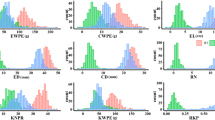Abstract
A population of 294 recombinant inbred lines (RIL) derived from Yuyu22, an elite maize hybrid extending broadly in China, has been constructed to investigate the genetic basis of grain yield, and associated yield components in maize. The main-effect quantitative trait loci (QTL), digenic epistatic interactions, and their interactions with the environment for grain yield and its three components were identified by using the mixed linear model approach. Thirty-two main-effect QTL and forty-four pairs of digenic epistatic interactions were detected for the four measured traits in four environments. Our results suggest that both additive effects and epistasis (additive × additive) effects are important genetic bases of grain yield and its components in the RIL population. Only 30.4% of main-effect QTL for ear length were involved in epistatic interactions. This implies that many loci in epistatic interactions may not have significant effects for traits alone but may affect trait expression by epistatic interaction with the other loci.

Similar content being viewed by others
Abbreviations
- QTL:
-
Quantitative trait loci
- QE:
-
QTL-by-environment interactions
- RIL:
-
Recombinant inbred line
- AA:
-
Additive interaction
- AAE:
-
Additive × additive by environment
References
Abler BS, Edwards M, Stuber CW (1991) Isoenzymatic identification of quantitative trait loci in crosses of elite maize inbreds. Crop Sci 31:267–274
Ajmone MP, Gorni C, Chittò A et al (2001) Identification of QTLs for grain yield and grain-related traits of maize (Zea mays L.) using an AFLP map, different testers, and cofactor analysis. Thero Appl Genet 102:230–243
Austin DF, Lee M (1996) Comparative mapping in F2:3 and F6:7 generations of quantitative trait loci for grain yield and yield components in maize. Theor Appl Genet 92:817–826
Austin DF, Lee M (1998) Detection of quantitative trait for grain yield and yield components in maize across generations in stress and nonstress environments. Crop Sci 38:1296–1308
Bateson W (1907) The progress of genetics since the rediscovery of Mendel’s paper. Progr Rei Bot 1:368
Beavis WD, Smith OS, Grant D et al (1994) Identification of quantitative trait loci using a small sample of topcrossed and F4 progeny from maize. Crop Sci 34:882–896
Cao GQ, Zhu J, He CX et al (2001) QTL analysis for epistatic effects and QTL × environment interaction effects on final height of rice (Oryza sativa L.). Acta Genetica Sinica 28(2):135–143
Cockerham CC, Zeng Z (1996) Design III with marker loci. Genetics 143:1437–1456
Darrah LL, Hallauer AR (1972) Genetic effects estimated from generation means in four diallel sets of maize inbreds. Crop Sci 12:615–621
Dudley JW, Lamkey KR, Geadelmann JL (1996) Evaluation of populations for their potential to improve three maize hybrids. Crop Sci 36:1553–1559
Falconer DS (1981) Introduction to quantitative genetics, 2nd edn. Longman Press, New York
Hinze LL, Lamkey KR (2003). Absence of epistasis for grain yield in elite maize hybrids. Crop Sci 43:46–56
Hua JP, Xing YZ, Wei WR et al (2003) Single-locus heterotic effects and dominance by dominance interactions can adequately explain the genetic basis of heterosis in an elite rice hybrid. Proc Natl Acad Sci USA 100:2574–2579
Hua JP, Xing YZ, Xu CG et al (2002) Genetic dissection of an elite rice hybrid revealed that heterozygotes are not always advantageous for performance. Genetics 162:1885–1895
Jansen RC, Ooijen JWV, Stam P et al (1995) Genotype-by-environment interaction in genetic mapping of multiple quantitative trait loci. Theor Apple Genet 91:33–37
Knapp SJ, Stroup WW, Ross WM (1985) Exact confidence intervals for heritability on a progeny mean basis. Crop Sci 25:192–194
Kosambi DD (1944) The estimation of map distances from recombination values. Ann Eugen 12:172–175
Lamkey KR, Schnicker BJ, Melchinger AE et al (1995) Epistasis in an elite maize hybrid and choice of generation for inbred line development. Crop Sci 35:1272–1281
Lander ES, Botstein D (1989) Mapping Mendelian factors underlying quantitative traits using RFLP linkage maps. Genetics 121:185–199
Li ZK, Luo LJ, Mei HW et al (2001) Overdominance epistatic loci are the primary genetic basis of inbreeding depression and heterosis in rice. I. Biomass and grain yield. Genetics 158:1737–1753
Li ZK, Pinson SRM, Paterson AH et al (1997) Epistasis for three grain yield components in rice (Oryza sativa L.). Genetics 145:453–465
Lincoln S, Daly M, Lander E (1992) Constructing genetics maps with MAPMAKER/EXP 3.0. Whitehead Institute Technical Report. Whitehead Institute, Cambridge, Massachusetts, USA
Lukens LN, Doebley J (1999) Epistatic and environmental interactions for quantitative trait loci involved in maize evolution. Genet Res 74:291–302
Luo LJ, Li ZK, Mei HW et al (2001) Overdominance epistatic loci are the primary genetic basis of inbreeding depression and heterosis in rice. II. Grain Yield Components. Genetics 158: 1737–1753
Mather K, Jinks JL (1982) Biometrical genetics, 3rd edn. Chapman and Hall, London
Mei HW, Li ZK, Shu QY et al (2005) Gene actions of QTL affecting several agronomic traits resolved in a recombinant inbred rice population and two backcross population. Theor Appl Genet 110:649–659
Mei HW, Lou LJ, Ying CS et al (2003) Gene actions of QTLs affecting several agronomic traits resolved in a recombinant inbred rice population and two testcross populations. Theor Apple Genet 107:89–101
Melchinger AE, Utz HF, Schon CC (1998) Quantitative trait locus (QTL) mapping using different testers and independent population samples in maize reveals low power of QTL detection and large bias in estimates of QTL effects. Genetics 149:383–403
Paterson AH, Lander ES, Had JD et al (1988) Resolution of quantitative traits into Mendelian factors by using a complete linkage map of restriction fragment length polymorphisms. Nature 335:721–726
Paterson AH, Damon S, Hewitt DJ et al (1991) Mendelian factors underlying quantitative traits in tomato: comparison across species, generations, and environments. Genetics 127:181–197
Pooni HS, Coombs DJ, Jinks PS (1987) Detection of epistasis and linkage of interacting genes in the presence of reciprocal differences. Heredity 58:257–266
Ragot M, Sisco PH, Hoisington DA et al (1995) Molecular-marker-mediated characterization of favorable exotic alleles at quantitative trait loci in maize. Crop Sci 35:1306–1305
Ribaut J, Jiang CZ, Gonzalez de Leon D et al (1997) Identification of quantitative trait loci under drought conditions in tropical maize .2. Yield components and marker-assisted selection strategies. Theor Appl Genet 94(6–7):887–896
Senior ML, Manfred H (1993) Mapping maize microsatellites and polymerase chain reaction confirmation of the targeted repeats using a CT primer. Genome 36:884–889
Spickett SG, Thoday JM (1966) Regular response to selection. 3. Interaction between located polygenes. Genet Res 7:96–121
Stuber CW, Willams WP, Moll RH (1973) Epistasis in maize (Zea mays L.): III. Significance in predictions of hybrid performances. Crop Sci 13:195–200
Stuber CW, Lincoln SE, Wolff DW et al (1992) Identification of genetic factors contributing to heterosis in a hybrid from two elite maize inbred lines using molecular markers. Genetics 132:823–839
Tanksley SD (1993) Mapping polygenes. Annu Rev Genet 27:205–233
Veldboom L, Lee M (1994) Molecular-marker-facilitated studies of morphological traits in maize. 2: Determination of QTLs for grain yield and yield components. Theor Appl Genet 89:451–458
Veldboom L, Lee M (1996) Genetic mapping of quantitative trait loci in maize in stress and nonstress environments. 1. Grain yield and yield components. Crop Sci 36:1310–1319
Veldboom L, Lee M, Woodman WL (1994) Molecular marker-facilitated studies in an elite maize population: 1. Linkage analysis and determination of QTL for morphological traits. Theor Appl Genet 88:7–16
Wang DL, Zhu J, Li ZK et al (1999) Mapping QTLs with epistatic effects and QTL × environment interactions by mixed linear model approaches. Theor Appl Genet 99:1255–1264
Xing YZ, Tan YF, Hua JP et al (2002) Characterization of the main effects, epistatic effects and their environmental interactions of QTLs on the genetic basis of yield traits in rice. Theor Appl Genet 105:248–257
Yan JB, Tang H, Huang YQ et al (2006) Quantitative trait loci mapping and epistatic analysis for grain yield and yield components using molecular markers with an elite maize hybrid. Euphytica 149:121–131
Yu SB, Li JX, Xu CG et al (1997) Importance of epistasis as the genetic basis of the heterosis in an elite rice hybrid. Proc Natl Acad Sci USA 94:9226–9231
Zeng ZB (1994) Precision mapping of quantitative trait loci. Genetics 136:1457–1468
Zhu J (1998) Mixed-model approaches of mapping genes for complex quantitative traits. In: Wang LZ, Dai JR (eds) Proceedings of genetics and crop breeding of China. Chinese Agricultural Science and Technology Publication House, Beijing, pp 19–20
Zhu JM, Mickelson SM, Kaeppler SM et al (2006) Detection of quantitative trait loci for seminal root traits in maize( Zea mays L.) seedlings grown under differential phosphorus levels. Theor Appl Genet 113:1–10
Zhu J, Weir BS (1998) Mixed-model approaches for genetic analysis of quantitative traits. In: Chen LS, Ruan SG, Zhu J (eds) Advanced topics in biomathematics. Proceedings of the international conference on mathematical biology. World Scientific, Singapore, pp 321–330
Zhuang JY, Lin HX, Lu J et al (1997) Analysis of QTL × environment interaction for yield components and plant height in rice. Theor Appl Genet 95:799–808
Acknowledgements
This work was supported by the State Key Basic Research and Development Plan of China and High Technology Project of China.
Author information
Authors and Affiliations
Corresponding author
Rights and permissions
About this article
Cite this article
Ma, X.Q., Tang, J.H., Teng, W.T. et al. Epistatic interaction is an important genetic basis of grain yield and its components in maize. Mol Breeding 20, 41–51 (2007). https://doi.org/10.1007/s11032-006-9071-9
Received:
Accepted:
Published:
Issue Date:
DOI: https://doi.org/10.1007/s11032-006-9071-9




